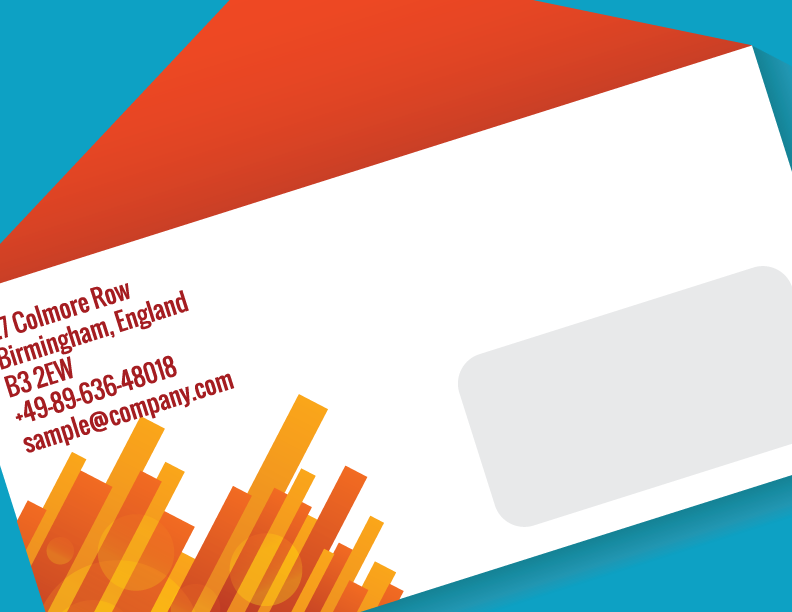
Cover photo created by macrovector_official – www.freepik.com
One of the most common ways to interact or reach your target audience is by sending them mail. Whether you’re sending a postcard, envelope, booklet, or catalog, it’s important to first do your research on USPS regulations; there’s nothing worse than creating a design to find out that it gets covered up by a stamp or other barcode once shipped out . If you want to create a mailer that keeps true to your brand identity while following the US Postal Service rules and regulations, follow these tips and tricks.
Envelope Design
Every piece of mail has designated sections the post office uses for shipping information, limiting where you can place designs. The most common of these is a 1” x 1” space in the upper right hand corner for a stamp, and the return address label placed in the top left corner, ¼” from the top and left side. According to Smartpress.com, the Intelligent Mail Barcode (IMB) is something the post office also places on the bottom right of your mail, and it’s 4 ⅞” wide by 3⁄4” tall. Envelopes also reserve the middle for the mailing address. Putting designs on these sections of the envelope can give the mail scanner difficulty while it attempts to read the barcode. Also, leave 1/16” around the border clear of any designs so they don’t get cut off while printing. Envelopes can have some color and designs, but it’s best to keep them light and away from covered areas. Smartpress offers more envelope guidelines on their website at https://smartpress.com/support/resources/direct-mail/mailing-design-guidelines#envelope_mailing.
Self Mailer and Brochure Design
These rectangular items are mailed out without being placed in an envelope, and range in size from 3 ½” to 6” tall and 5” to 10 ½” in length when folded. One side is typically designed to have all the shipping information, so the remaining sections can focus on the content. Self mailers need to leave at least 1/16th of an inch around the border without designs. When creating your design, it’s important to know self mailers are shut with 2-3 wafer seals, which take up more of your design space. Self mailers need room for the return address, mailing address, stamp and IMB just like the envelope guidelines, and Smartpress.com notes they need to be placed on your mailer in line with the longest side. For more self mailer design guidelines, visit https://smartpress.com/support/resources/direct-mail/mailing-design-guidelines#self_mailer.
Catalogs and Booklet Design
These stapled mail pieces have similar guidelines to self mailers: they need room for the return address ¼” from the top and left side, a stamp in the top right corner, mailing address in the middle, and the IMB on the bottom right. One thing that sets booklets apart is they have wafer seals on both of the short ends of the mailer. Keeping their locations in mind while designing your layout is critical to ensure your branding isn’t covered up. As always, allow a 1/16” area around the border to make sure your design doesn’t get cut short. A visual template of a booklet layout is available at https://smartpress.com/support/resources/direct-mail/mailing-design-guidelines#booklet_mailing.
Postcard Design
Postcards have a smaller area to work with, so one side of the postcard is focused on content while the other side mainly contains the necessary mailing information. Postcards need all the standard items that were outlined for a booklet: (stamp, return address label, IMB label on the bottom right half), but also have a section called the address area. According to Smartpress.com, this section needs to be ½” from the left and right of the postcard, 2 ⅛” tall, and ¾” up from the bottom. This is required on a postcard, and needs a ⅛” gap between the address block and other items. As always, leave a 1/16” gap around the border to ensure no part of the design is cut off. Details are further outlined at https://smartpress.com/support/resources/direct-mail/mailing-design-guidelines#postcard_mailing.
Final Thoughts
While considering the regulations for mailers, make your design consistent with your brand identity. From the letterhead, color scheme, and font choices, a recipient of your mailer should be able to recognize your brand. Also, be sure to consider how you’ll send out your mailer. Popular options include Every Door Direct Mail (which targets all locations within your local area), and USPS Marketing Mail (which will reach a much larger audience).

